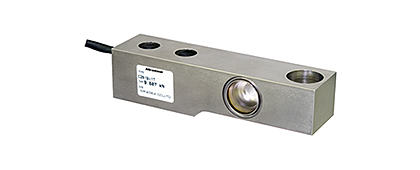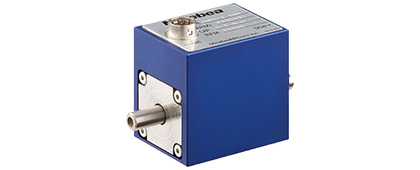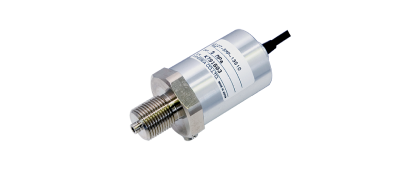What is a force sensor (load sensor)?
What is a force sensor?
Explanation of types, applications, and measurement principles
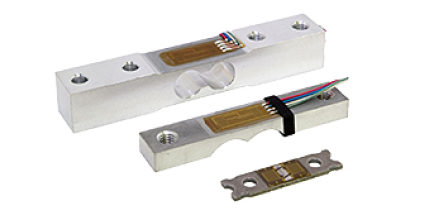
A force sensor is the generic name for sensors that measure the size of various forces and loads. A broad variety of products are available, ranging from sensors that simply measure weight such as with a scale, to those that measure the pressure of the flow of water through a pipe, and those that simultaneously measure the force applied to a robot's fingertips from multiple directions.
This section describes the specific types of force sensors available as well as where and in what applications they are used. The measurement principle of force sensors will also be outlined in more detail.
1. A force sensor is a sensor that detects and measures force
“Force” refers to energy or power, and the word “sensor” means to detect or identify. A combination of these two words, force sensors are sensors that electrically sense or measure the force acting on an object.
Force sensors are used in factory production lines and are sometimes incorporated into end products, but they share the same basic measurement principles and structure.
A broad variety of types have been developed in terms of both size and shape, depending on the application and location of use. For example, there are force sensors shaped like mechanical parts, and there are also sheet force sensors that can be wrapped around pipes to measure pressure.
2. Types and Applications of Force Sensors
There are different types of force sensors, such as load cells, torque sensors and pressure sensors, which can be used for different purposes and in different locations.
To illustrate what specific types of force sensors available, these are some typical examples.
Load cell
A load cell is a force sensor that uses a sensor component called a strain gage. Also called "load transducers," load cells are connected to various measuring instruments for measurement purposes, and are used to display, record, control, and manage the force applied to the applicable section.
Load cells have a broad variety of applications ranging from industrial, medical and aerospace to consumer electronics used by the general public. Some specific examples include truck scales for measuring vehicles and vehicle loads, tank scales for measuring substances in tanks, and sensors for various weighing and strength tests on production lines. Other familiar applications include weight scales, game consoles and various home appliances.
What is a load cell? Explanation of how it works, types, and points for selection
Torque sensor
Torque sensors are sensors that measure the torsion that is applied to shafts, and are also called "torque transducers," " torque gauges" or "torque meters." Torque is the force generated when an object is rotated with respect to a fixed rotating shaft, and is the turning and twisting force. For example, the force applied when opening the lid of a plastic bottle or jar is also called torque.
Torque sensors are often used to measure torque in the drive units of various powertrain systems, such as automobile engines, motors and transmissions, and may be familiar to those who like cars and motorcycles. They are also used to accurately measure torque on production lines in factories.
What is a torque meter? Explanation of how it works, types, and points for selection.
Force sensor
While load cells and torque sensors measure forces acting in a fixed direction, force sensors are able to measure forces in multiple axes acting together on a single point.
Force sensors are often used in situations that require advanced and flexible reactions, and are generally mounted on sections like the end or fingertips of a robot arm to serve as tactile sensors. They are also used as sensors in keyboards and other input devices to determine if an operator has pressed a key.
In recent years, robots have become available on the market with highly precise senses that are similar to human fingertips, and robots are increasingly taking the place of humans in performing delicate tasks that only humans could perform in the past. It is no exaggeration to say that force sensors played a role in this.
MinebeaMitsumi has a 3-axis type available that measures forces acting in 3 directions (X, Y and Z), and a 6-axis type that measures 6 axes by multiplying those 3 axes by torque.
Pressure sensor
Pressure sensors, also called "pressure gauges," are force sensors made for measuring the pressure and frictional force of fluids such as oil and water flowing through pipes and equipment. Capable of highly flexible designs, some products are also shaped into thin films, as they are often used by being wrapped around pipes.
Uses of pressure sensors include measuring water pressure at hydraulic power plants, at plants that measure oil pressure, for gas combustion pressure measurement, and with high-pressure sterilization equipment.
3. Features of strain gages used in force sensors
There are many types of force sensors, and their measurement principles vary. The main measurement principles include the "strain gage method," which uses strain gages, the "piezoresistive method," which uses mechanical strain in semiconductor crystals, and the "piezoelectric method," which uses two crystal plates.
This section outlines in detail the strain gages used in MinebeaMitsumi's force sensors.
Mechanism and structure of strain gages
Strain gages are sensor components that make use of the mechanism where resistance increases or decreases when a metallic substance is stretched or compressed by an external force. Force sensors using these components are called the strain gage type.
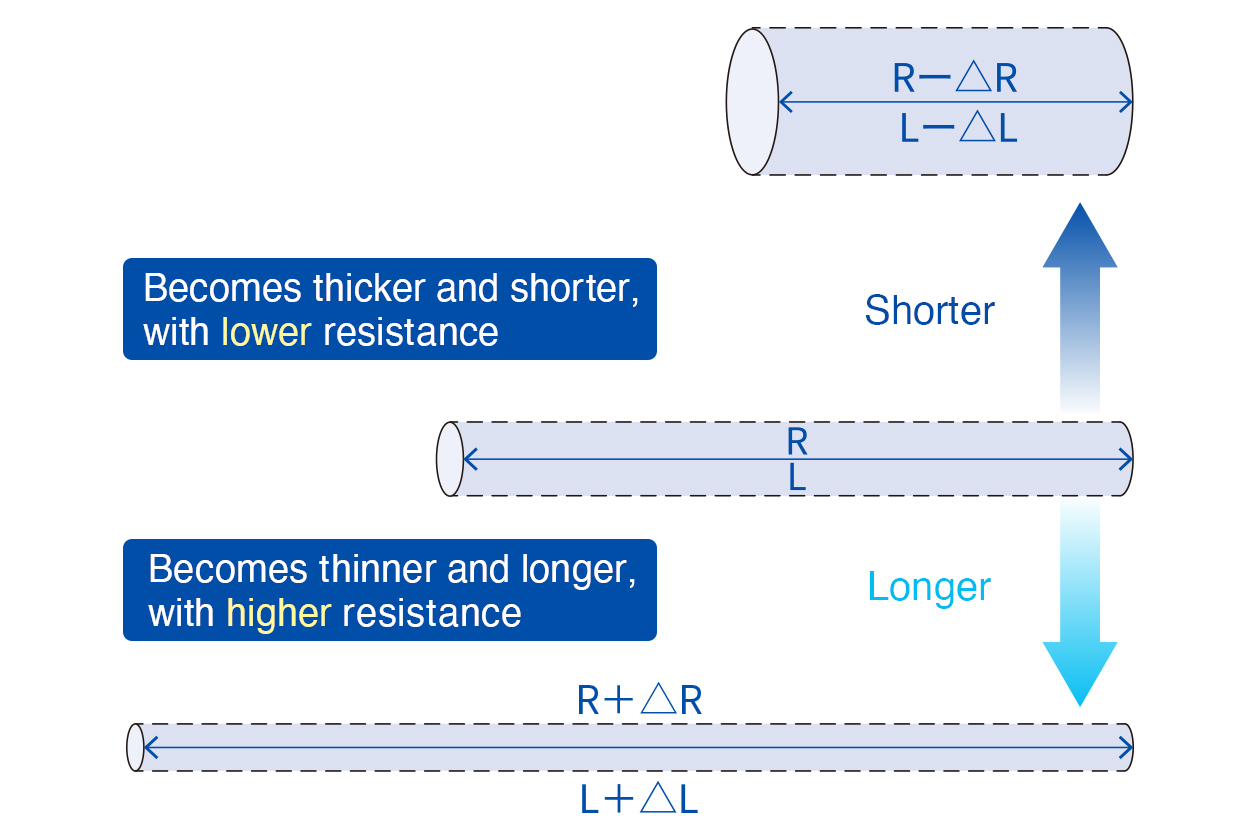
Principle of measuring strain
MinebeaMitsumi measures the force acting on an object precisely by printing a pattern on a metallic resistive foil approximately 6 μm (0.006 mm) thick, and attaching an etched strain gage to a part called the strained body that generates strain.
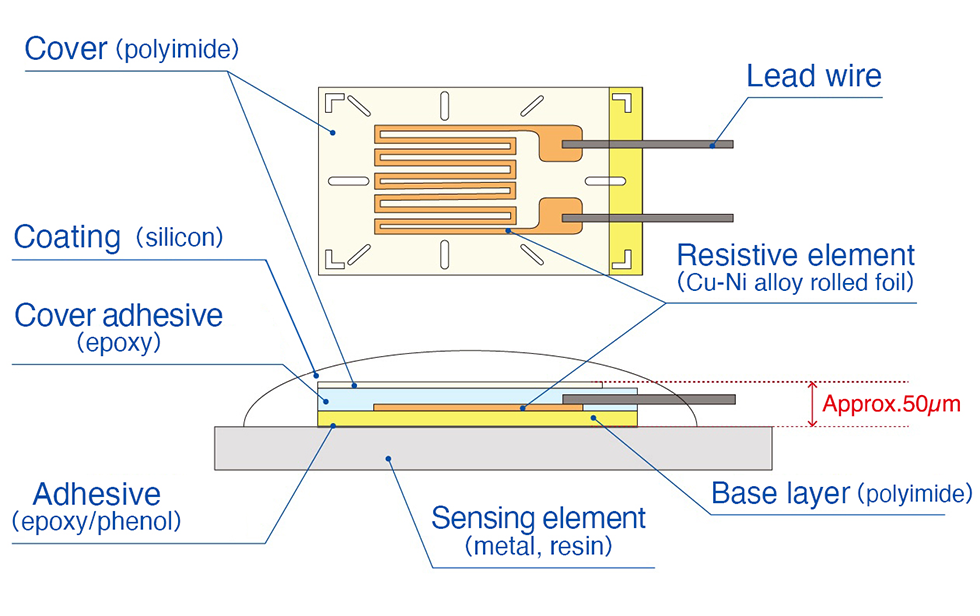
The change in resistance due to the strain of an object is extremely small. For this reason, strain gages use a circuit called a "Wheatstone bridge" to measure the amount of electricity.
Self-temperature compensation of strain gages
Accurate measurements of force sensors require strain gages to be adjusted to the temperature. This is because when performing measurements with a strain gage force sensor attached to the actual force acting on the object, the difference in expansion between the metal resistive element of the strain gage and the object being measured causes an apparent strain due to temperature—a factor that can result in errors.
Yet this factor can also be eliminated by using a Wheatstone bridge circuit. Strain gages using this circuit are called the self-temperature compensated type, and all MinebeaMitsumi strain gages are of this type. Therefore, MinebeaMitsumi strain gage force sensors can be used in a variety of temperature environments.
Advantages of strain gages
The advantage of strain gages is that they can be used for many materials including metals and plastics due to their excellent sensitivity, stability and robustness, as well as ease-of-handling.
Given these advantages, force sensors made with strain gages are used in a wide range of fields.
4. If you need a force sensor, contact MinebeaMitsumi and inquire about our extensive product lineup
Force sensors are simple in principle, but there are products suitable for a range of applications. Those thinking about using force sensors should first consider what application they want to use them for.
MinebeaMitsumi offers a wide variety of measuring instruments as well as force sensors as outlined in this article. If you are seeking to deploy force sensors, do not hesitate to send us an inquiry.
For product-related inquiries, please contact us using the form below.
Related page
Contact Us
Please click the inquiry type below according to your question. Each product / sales representative will respond to you.
